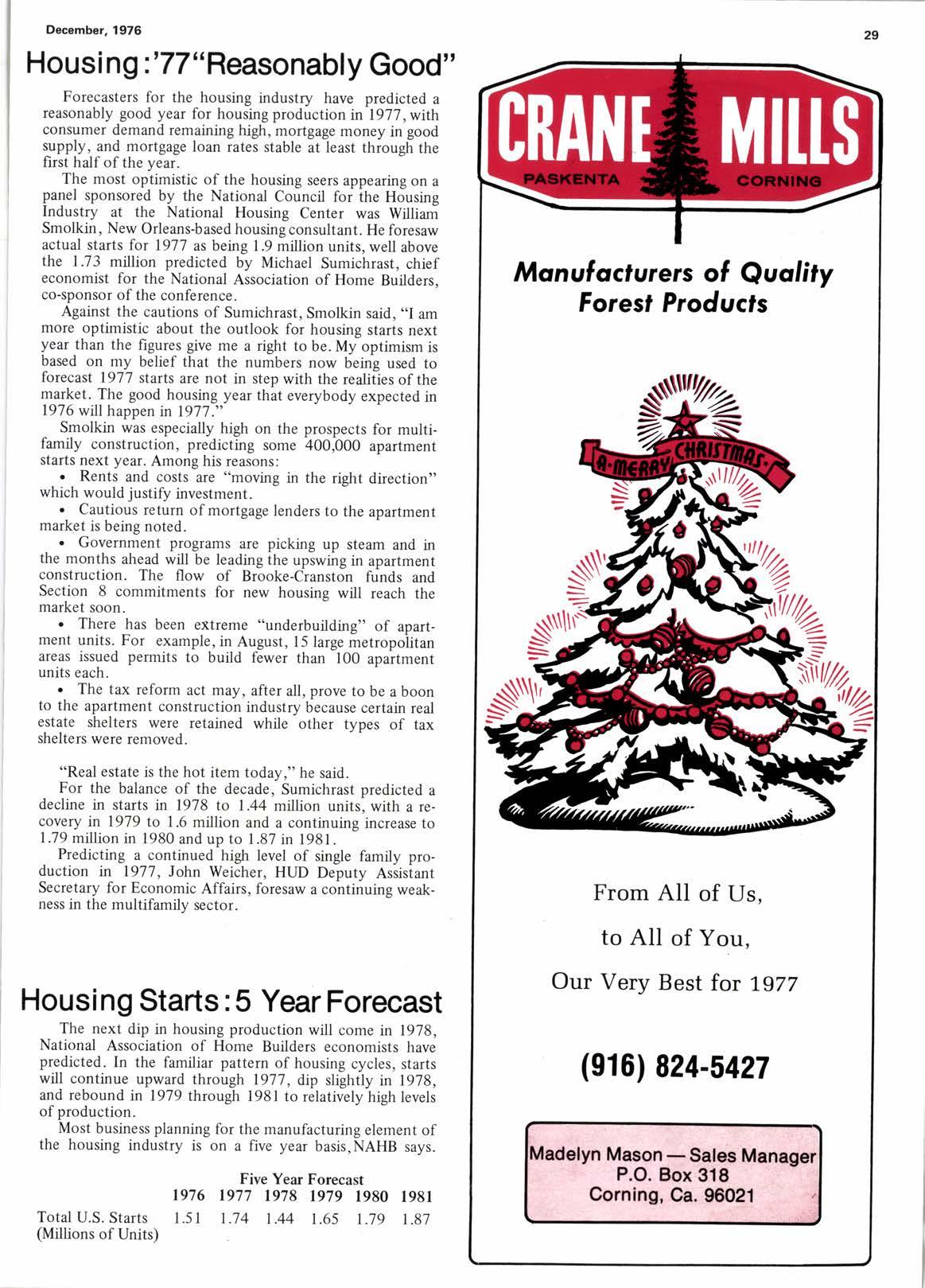
2 minute read
Housi ng :'TT "Reasonably Good"
Forecasters for the housing industry have predicted a reasonably good year for housing production in 1977 ,with consumer demand remaining high, mortgage money in good s-upply, and mortgage loan rates stable at least through the first half of the year.
The most optimistic of the housing seers appearing on a panel sponsored by the National Council for the Housing Industry at the National Housing Center was William Smolkin, New Orleans-based housing consultant. He foresaw actual starts for 1977 as being 1.9 million units, well above the 1.73 million predicted by Michael Sumichrast, chief economist for the National Association of Home Builders, co-sponsor of the conference.
Against the cautions of Sumichrast, Smolkin said, "I am more optimistic about the outlook for housing starts next year than the figures give me a right to be. My optimism is based on my belief that the numbers now being used to forecast 1977 starts are not in step with the realities of the market. The good housing year thit everybody expected in 1976 wrll happen in 1977 ;'
Smolkin was especially high on the prospects for multifamily construction, predicting some 400000 apartment starts next year. Among his reasons:
. Rents and costs are "moving in the right direction" which would justify investment.
Cautious return of mortgage lenders to the apartment market is being noted.
Government programs are picking up steam and in the months ahead will be leading the upswing in apartment construction. The flow of Brooke-Cranston funds and Section 8 commitments for new housing will reach the market soon.
. There has been extreme "underbuilding" of apartment units. For example, in August, l5 large metropolitan areas issued permits to build fewer than 100 apaitment units each.
. The tax reform act may, after all, prove to be a boon to the apartment construction industry because certain real estate shelters were retained while other types of tax shelters were removed
"Real estate is the hot item today," he said.
For the balance of the decade, Sumichrast predicted a decline in starts in 1978 to 1.44 million units. with a recovery in 1919 to 1.6 million and a continuing increase to 1.79 million in 1980 and up to 1.87 in 1981.
Predicting a continued high level of single family production in l97l , John Weicher, HUD Deputy Assistant Secretary for Economic Affairs, foresaw a continuing weakness in the multifamilv sector.
Housing Starts:5 Year Forecast
The next dip in housing production will come in 1978, National Association of Home Builders economists have predicted. In the familiar pattern of housing cycles, starts will continue upward through 1977, dip slightly in 1978, and rebound in 1979 through 1981 to relatively high levels of production.
Most business planning for the manufacturing element of the housing industry is on a five year basis,NAHB says.

E'CONOMISTS are "guardedly" or E "cautiously" optimistic about business conditions in general for the coming year, pointing out that the 8%-9% GNP rate enjoyed early in the year was bound to drop back anyway, and that even the current 4Vr5% rate represents an improvement over the past couple ofyears.
The housing industry which directly affects the sales of hardwood plywood products looks somewhat stronger than the economy as a whole, partly because it fell more sharply during 1974 and 1975 and, therefore, has farther to recover.
Total shipments of prefinished hardwood plywood paneling, accounting for two-thirds of annual consumption, may reach the 3.5 billion square feet mark, compared with less than 3.0 billion last year. Most of this improvement is attributable to conventional housing starts and the late-season recovery in mobile homes, but it also reflects a substantial increase in professional and do-it-yourself remodeling as property owners opt for upgrading what they have rather than buying something else. This trend should give the building products merchant special cause for "selective" optimism for the










